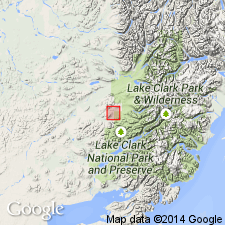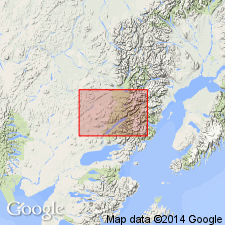
- Usage in publication:
-
- Chilikadrotna Greenstone
- Modifications:
-
- Named
- Dominant lithology:
-
- Greenstone
- Basalt
- Volcaniclastics
- AAPG geologic province:
-
- Alaska Southwestern region
Summary:
Type area: Upper Chilikadrotna River, Lake Clark [C-4, C-5] quad, south Alaska. Consists of olive-gray to dark-green, weathering brown to maroon metamorphosed basalt (greenstone), hematite-rich basalt, and andesite, with interbedded limestone lenses and volcaniclastic sedimentary rocks. Greenstone is massive and ridge-forming; limestone is fossiliferous. Is in probable high-angle fault contact on all sides with Upper Jurassic sedimentary and volcanic rocks. Is early Late Silurian (Wenlockian) age based on brachiopods and pelecypod identified by Blodgett.
Source: GNU records (USGS DDS-6; Menlo GNULEX).

- Usage in publication:
-
- Chilikadrotna Greenstone*
- Modifications:
-
- Overview
- AAPG geologic province:
-
- Alaska Southwestern region
Summary:
Unit of Bundtzen and others (1979) here adopted. Type locality designated as unnamed hills north of Chilikadrotna River, T6N, R30-31W near center of Lake Clark quad, south AK. Map shows location of unit and fossil locality of Bundtzen and others (1979). Age is early Late Silurian. Metamorphism is possibly pre-Jurassic.
Source: GNU records (USGS DDS-6; Menlo GNULEX).
For more information, please contact Nancy Stamm, Geologic Names Committee Secretary.
Asterisk (*) indicates published by U.S. Geological Survey authors.
"No current usage" (†) implies that a name has been abandoned or has fallen into disuse. Former usage and, if known, replacement name given in parentheses ( ).
Slash (/) indicates name conflicts with nomenclatural guidelines (CSN, 1933; ACSN, 1961, 1970; NACSN, 1983, 2005, 2021). May be explained within brackets ([ ]).

